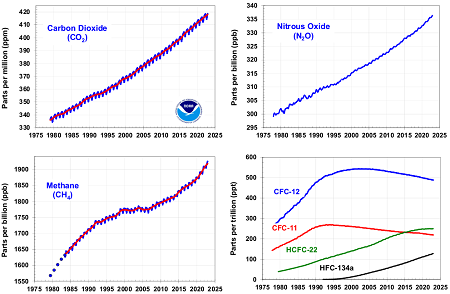3. Climate and climate change
The climate crisis (2/3)
Other greenhouse gases, global data
How have the amount of greenhouse gases in the atmosphere changed in the last few decades? Many scientific institutes measure this regularly and publish their results. One example is the US National Oceanic and Atmospheric Administration NOAA, which has operated a global measurement network since 1979.

The NOAA Global Greenhouse Gas Reference Network (GGGRN) with locations where air samples taken from the surface of the Earth and also with aircraft at greater altitudes. These samples are then analysed in the laboratory. Status spring 2023, updated annually.
Source: The NOAA Annual Greenhouse Gas Index (AGGI).
The graph in the right column shows global mean concentrations of carbon dioxide (CO2), nitrous oxide (N2O), methane (CH4) and halogenated hydrocarbons in the atmosphere as time series since 1979, calculated from data measured at the Global Greenhouse Gas Reference Network (GGGRN).
Only trichlorofluoromethane (CFC-11), used as a refrigerant in refrigerators, and dichlorodifluoromethane (CFC-12), used as a propellant in spray cans, have decreased. The use of these substances has been internationally banned by the Montreal Protocol since 1987 because they deplete atmospheric ozone.

Time series of some gases that have been introduced into the atmosphere since 1979 due to human influence and increase the greenhouse effect. The data for CO2 and CH4 are shown monthly (blue) and as a moving annual average (red). As of spring 2023, updated annually.
The units at the ordinates: ppm are parts per million or 10-6, ppb are parts per billion or 10-9. 400 ppm carbon dioxide thus corresponds to 400 millionths or 0.4 thousandths or 0.04 per cent.
Source: The NOAA Annual Greenhouse Gas Index (AGGI).
The effectiveness of gases is compared with the effect of CO2 and referred to as Global Warming Potential (GWP). CH4 is about 25 times and N2O about 298 times more effective than the same mass of CO2.
